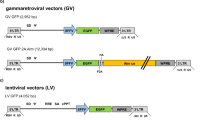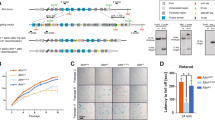Abstract
Ataxia-telangiectasia (A-T) is an autosomal recessive disorder characterized by neurodegeneration, immunodeficiency, cancer predisposition, genome instability and radiation sensitivity. The cellular phenotype of A-T points to defects in signal transduction pathways involved in activation of cell cycle checkpoints by free radical damage, and other pathways that mediate the transmission of specific mitogenic stimuli. The product of the responsible gene, ATM, belongs to a family of large proteins that contribute to maintaining genome stability and cell cycle progression in various organisms. A recombinant vector that stably expresses a full-length ATM protein is a valuable tool for its functional analysis. We constructed and cloned a recombinant, full-length open reading frame of ATM using a combination of vectors and hosts that overcame an inherent instability of this sequence. Recombinant ATM was stably expressed in insect cells using a baculovirus vector, albeit at a low level, and in human A-T cells using an episomal expression vector. An amino-terminal FLAG epitope added to the protein allowed highly specific detection of the recombinant molecule by immunoblotting, immunoprecipitation and immunostaining, and its isolation using immunoaffinity. Similar to endogenous ATM, the recombinant protein is located mainly in the nucleus, with low levels in the cytoplasm. Ectopic expression of ATM in A-T cells restored normal sensitivity to ionizing radiation and the radiomimetic drug neocarzinostatin, and a normal pattern of post-irradiation DNA synthesis, which represents an S-phase checkpoint. These observations indicate that the recombinant, epitope-tagged protein is functional. Introduction into this molecule of a known A-T missense mutation, Glu2904Gly, resulted in apparent instability of the protein and inability to complement the A-T phenotype. These findings indicate that the physiological defects characteristic of A-T cells result from the absence of the ATM protein, and that this deficiency can be corrected by ectopic expression of this protein.
This is a preview of subscription content, access via your institution
Access options
Subscribe to this journal
Receive 50 print issues and online access
$259.00 per year
only $5.18 per issue
Buy this article
- Purchase on Springer Link
- Instant access to full article PDF
Prices may be subject to local taxes which are calculated during checkout
Similar content being viewed by others
Author information
Authors and Affiliations
Rights and permissions
About this article
Cite this article
Ziv, Y., Bar-Shira, A., Pecker, I. et al. Recombinant ATM protein complements the cellular A-T phenotype. Oncogene 15, 159–167 (1997). https://doi.org/10.1038/sj.onc.1201319
Received:
Accepted:
Issue Date:
DOI: https://doi.org/10.1038/sj.onc.1201319
Keywords
This article is cited by
-
Repair of DNA damage induced by the novel nucleoside analogue CNDAG through homologous recombination
Cancer Chemotherapy and Pharmacology (2020)
-
Prevalence and characterization of ATM germline mutations in Chinese BRCA1/2-negative breast cancer patients
Breast Cancer Research and Treatment (2019)
-
ATM and CDK2 control chromatin remodeler CSB to inhibit RIF1 in DSB repair pathway choice
Nature Communications (2017)
-
miR-34 activity is modulated through 5′-end phosphorylation in response to DNA damage
Nature Communications (2016)
-
ATM function and its relationship with ATM gene mutations in chronic lymphocytic leukemia with the recurrent deletion (11q22.3-23.2)
Blood Cancer Journal (2016)



